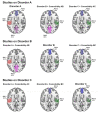Focusing on Comorbidity-A Novel Meta-Analytic Approach and Protocol to Disentangle the Specific Neuroanatomy of Co-occurring Mental Disorders
- PMID: 35115973
- PMCID: PMC8805083
- DOI: 10.3389/fpsyt.2021.807839
Focusing on Comorbidity-A Novel Meta-Analytic Approach and Protocol to Disentangle the Specific Neuroanatomy of Co-occurring Mental Disorders
Abstract
Background: In mental health, comorbidities are the norm rather than the exception. However, current meta-analytic methods for summarizing the neural correlates of mental disorders do not consider comorbidities, reducing them to a source of noise and bias rather than benefitting from their valuable information.
Objectives: We describe and validate a novel neuroimaging meta-analytic approach that focuses on comorbidities. In addition, we present the protocol for a meta-analysis of all major mental disorders and their comorbidities.
Methods: The novel approach consists of a modification of Seed-based d Mapping-with Permutation of Subject Images (SDM-PSI) in which the linear models have no intercept. As in previous SDM meta-analyses, the dependent variable is the brain anatomical difference between patients and controls in a voxel. However, there is no primary disorder, and the independent variables are the percentages of patients with each disorder and each pair of potentially comorbid disorders. We use simulations to validate and provide an example of this novel approach, which correctly disentangled the abnormalities associated with each disorder and comorbidity. We then describe a protocol for conducting the new meta-analysis of all major mental disorders and their comorbidities. Specifically, we will include all voxel-based morphometry (VBM) studies of mental disorders for which a meta-analysis has already been published, including at least 10 studies. We will use the novel approach to analyze all included studies in two separate single linear models, one for children/adolescents and one for adults.
Discussion: The novel approach is a valid method to focus on comorbidities. The meta-analysis will yield a comprehensive atlas of the neuroanatomy of all major mental disorders and their comorbidities, which we hope might help develop potential diagnostic and therapeutic tools.
Keywords: comorbidity; gray matter (GM); magnetic resonance imaging (MRI); medication; mental disorder; meta-analysis; seed-based d mapping (SDM).
Copyright © 2022 Fortea, Albajes-Eizagirre, Yao, Soler, Verdolini, Hauson, Fortea, Madero, Solanes, Wollman, Serra-Blasco, Wise, Lukito, Picó-Pérez, Carlisi, Zhang, Pan, Farré-Colomés, Arnone, Kempton, Soriano-Mas, Rubia, Norman, Fusar-Poli, Mataix-Cols, Valentí, Via, Cardoner, Solmi, Shin, Vieta and Radua.
Conflict of interest statement
NV has received financial support for CME activities and travel funds from the following entities (unrelated to the present work): Angelini, Janssen-Cilag, Lundbeck, Otsuka. EVia is a co-investigator in a Janssen-Cilag, S.A., clinical trial with the esketamine molecule (unrelated to the present work). KR received a grant from TAKEDA pharmaceutical for another project and consulting fees from Lundbeck and Supernus (unrelated to the present work). The remaining authors declare that the research was conducted in the absence of any commercial or financial relationships that could be construed as a potential conflict of interest.
Figures



References
-
- DeLisi LE, Goldin LR, Hamovit JR, Maxwell ME, Kurtz D, Nurnberger JI, et al. . Cerebral ventricular enlargement as a possible genetic marker for schizophrenia. Psychopharmacol Bull. (1985) 21:365–7. - PubMed

